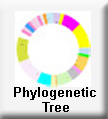


|
syn..
|
Criconemoides curvatus Raski, 1952
Macroposthonia curvata (Raski, 1952) De Grisse & Loof, 1965 Criconemella curvata (Raski, 1952) Luc & Raski, 1981 Criconemoides tescorum de Guiran, 1963 synonymised by Luc (1970) Macroposthonia tescorum (de Guiran, 1963) De Grisse & Loof, 1965 Criconemella tescorum (de Guiran, 1963) Ebsary, 1982 Criconemoides nainitalensis Edward & Misra, 1963 Macroposthonia nainitalensis (Edward & Misra) De Grisse & Loof, 1965 Macroposthonia coomansi De Grisse, 1967 Mesocriconema coomansi (De Grisse, 1967) Loof & De Grisse, 1989 Criconemoides dorsoflexus Boonduang & Ratanaprapa, 1974 Macroposthonia dorsoflexa (Boonduang & Ratanaprapa, 1974) Siddiqi, 1986 Macroposthonia rusium Khan, Chawla & Saha, 1976 Criconemella rusium (Khan, Chawla & Saha, 1976) Luc & Raski, 1981 Mesocriconema rusium (Khan, Chawla & Saha, 1976) Loof & De Grisse, 1989 Mesocriconema ritteri Doucet, 1981 Criconemella ritteri (Doucet, 1981) Chaves, 1984 |
Larva. Head and tail bluntly rounded as in female. Sublateral lobes present. Spear 41-46 u long. Total annules 80-88, no cuticular markings present.
Female. Oral opening obscure at surface, shows internally
as oval slit near base of sclerotization. Conspicuous elevated labial
disc surrounds oral opening. Amphid apertures obscure, appear to
be narrow, darkened slits on lateral margins of labial disc. Labial
disc expands laterally near base to accommodate amphidial pouches.
Sclerotization hexaradiate with innervations in four submedian sectors.
Sublateral labes conspicuous, placed equadistant about labial disc.
Ventro-sublateral lobes and dorso-sublateral labes connected between each
other, but no connections between sublateral lobes dorso-ventrally.
First annule variable, usually divided into four labial plates but may
be reduced in number and/or size or divided only in some sectors.
First two annules smaller and narrower than succeeding annules but not
set off, presenting a bluntly rounded outline.
Spear length 47-67 u. Excretory pore on 21-29th annule
from anterior end. Vulva on 6-10th annule from end of body, generally
on 7-8th annule. Anterior flap of vulva variable, usually presents
a slightly bilobed appearance but may be simple in outline. Anastomosis
with preceeding or succeeding annules often complicates vulva pattern.
Ovary extends 30.9-70.7% of body length. Anus on 5-6th annule from
end of body. Terminus
simple, rounded or lobed. Total annules 78-101.
Male. Lip region low rounded, no striae present on lips.
Sublateral lobes small, placed equadistant about labial disc. Innervations
of amphids present but amphid apertures obscure. Hexaradiaate sclerotization
delicate, extending approximately four annules posterior to lip region.
Spear
absent, esophagus and intestine indistinct.
Lateral field marked by four incisures. Excretory pore 88-91u
from anterior end of body. Hemizonid about 1.5 annules wide, located
two annules anterior to excretory pore.
Spicules
27u long, definitely curved. Gubernaculum simple, rod-like,
5 u long. Spicule sheath protrudes conspicuously but lacks
the posterior process present in C. xenoplax. Body constricts
posterior to spicules, coarsely annulated. Tail pointed with rounded terminus.
Bursa small, begins slightly anterior to cloacal opening and extends almost
to terminus. Lateral lines extend varying distance on bursa.
Males rare, known only from type locality.
Type Habitat: Soil taken about the roots of snapdragon (Antirrhinum
sp.)
Type Locality: Near Colma, San Mateo County, California
Diagnosis: Criconemoides curvatum is most closely related
to C. xenoplax from which it differs in the smaller size of males
and females and in the shorter spear of females. In addition, the
male tail of cuvatum is more pointed, the spicules more strongly curved
and the lip region less elevated. The larvae have no cuticular markings
on the annules which differs from the longitudinal cuticular markings on
the larvae of C. xenoplax.
This species keys to C. rusticum according to Taylor (1936)
from which it differs in the posession of sublateral lobes on the lip region
and in the rounded shape of the head and tail.
-- Raski, 1952
This species included in the Criconematid Project
DNA Sequences Obtained
| Specimen: | Collected: |
| KonzaII BB-102 | Konza Prairie, First survey |
| 9Mile 3-5 LP2-23 | 9 Mile Prairie |
| LCC N | Lincoln Country Club |
| 9MileLP2-19 | 9 Mile Prairie |
| NE61-02 (16124) | Polk county, Nebraska |
| NE61-01 (16123) | Polk county, Nebraska |
| Sheeder L1-05 (15556) | Sheeder Prairie, Iowa |
| 9MileSW2-10 (13458) | 9 Mile Prairie |
 |
 |
 |